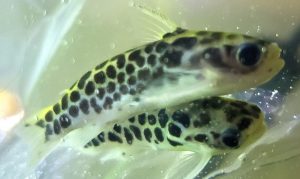The Honeycomb Catfish (Centromochlus perugiae) known to tropical fish keeping enthusiasts as the Oil Catfish or Driftwood Catfish is found around the shorelines of swiftly flowing rivers and streams in Ecuador and Peru.
Centromochlus perugiae are usually collected over sandy substrates in areas with little to no aquatic vegetation.
Honeycomb Catfish are a small, peaceful, nocturnal species that are ideally suited for South American biotope aquariums or other peaceful community tanks. During the day, they hide among rocks, logs, or bogwood in spaces barely large enough for them to get into, and at dusk come out to greedily forage on small insects, crustaceans, larvae, worms, etc.
The Honeycomb Catfish is covered with irregular black splotches over a white body and has translucent fins.
Adults develop a hint of yellow from the snout to just behind the dorsal fin and have blue irises. Males have an extended anal fin similar in use to the gonopodium possessed by live bearers.
Females are much rounder when viewed from above, especially when gravid.
Honeycomb Catfish are best housed in a dimly lit riverine aquarium of at least 10 gallon capacity with a sandy substrate, plenty of bogwood, and a enough smooth river rocks for them to hide among. They need a current in their tank so a bio-wheel filter or small power head is necessary to replicate their natural habitat.
Honeycomb Catfish are often housed with tetras, dwarf cichlids, Corydoras sp. and any of the smaller Loricariids.
Because Honeycomb Catfish cannot see red wavelengths, many tropical fish keeping enthusiasts use a red spectrum LED to view them feeding at night or during the evening hours.
Centromochlus perugiae are easy to breed under the right conditions. They will not spawn if the breeding tank does not have enough water flow and enough small crevices for them to deposit their eggs. Many tropical fish keeping enthusiasts use small pieces of 1/2″ or smaller diameter PVC pipe with great success, but moderate to strong water flow is essential for successful spawning.
Like other Aurhcnipterids, Honeycomb catfish fertilize their eggs internally through the use of the male’s modified anal fin.
Once the eggs are deposited, the female will guard them until they hatch out. Most breeders will immediately separate the fry from the parents at this stage to avoid predation and relocate them into a rearing tank with an aged sponge filter and some Riccia or other floating fine leaved plant.
In about a week, after the yolk sacs are absorbed and the fry become free swimming, they can be fed newly hatched brine shrimp, microworms, etc. The fry hide off the substrate near the surface among the floating plants and like the adults will feed only at night or in dark conditions.
In their natural environment, Honeycomb Catfish feed on insects, worms, small crustaceans, and occasionally filamentous algae. In an aquarium environment, they are voracious eaters that will accept live, frozen, or freeze dried bloodworms, tubifex
, earthworms, brine shrimp, red wrigglers, and sinking pellets
.
Feed them after the lights are turned off over the aquarium.
Honeycomb Catfish (Centromochlus perugiae) are not a common item in tropical fish keeping shops but are occasionally available online at a variety of auction, forum, wholesale, and retail sites when they are 1.25″ to 2″ in size.
Minimum Tank Size: 10 gallons
Care Level: Moderate
Temperament: Peaceful
Aquarium Hardiness: Hardy
Water Conditions: 75-86°C, 1-25°H, pH 4.9-8.0
Max. Size: 2.5″
Color Form: Black, White
Diet: Omnivore
Compatibility: Shoaling, Community
Origin: Ecuador, Peru
Family: Auchenipteridae
Lifespan: 5-8 years
Aquarist Experience Level: Beginner





